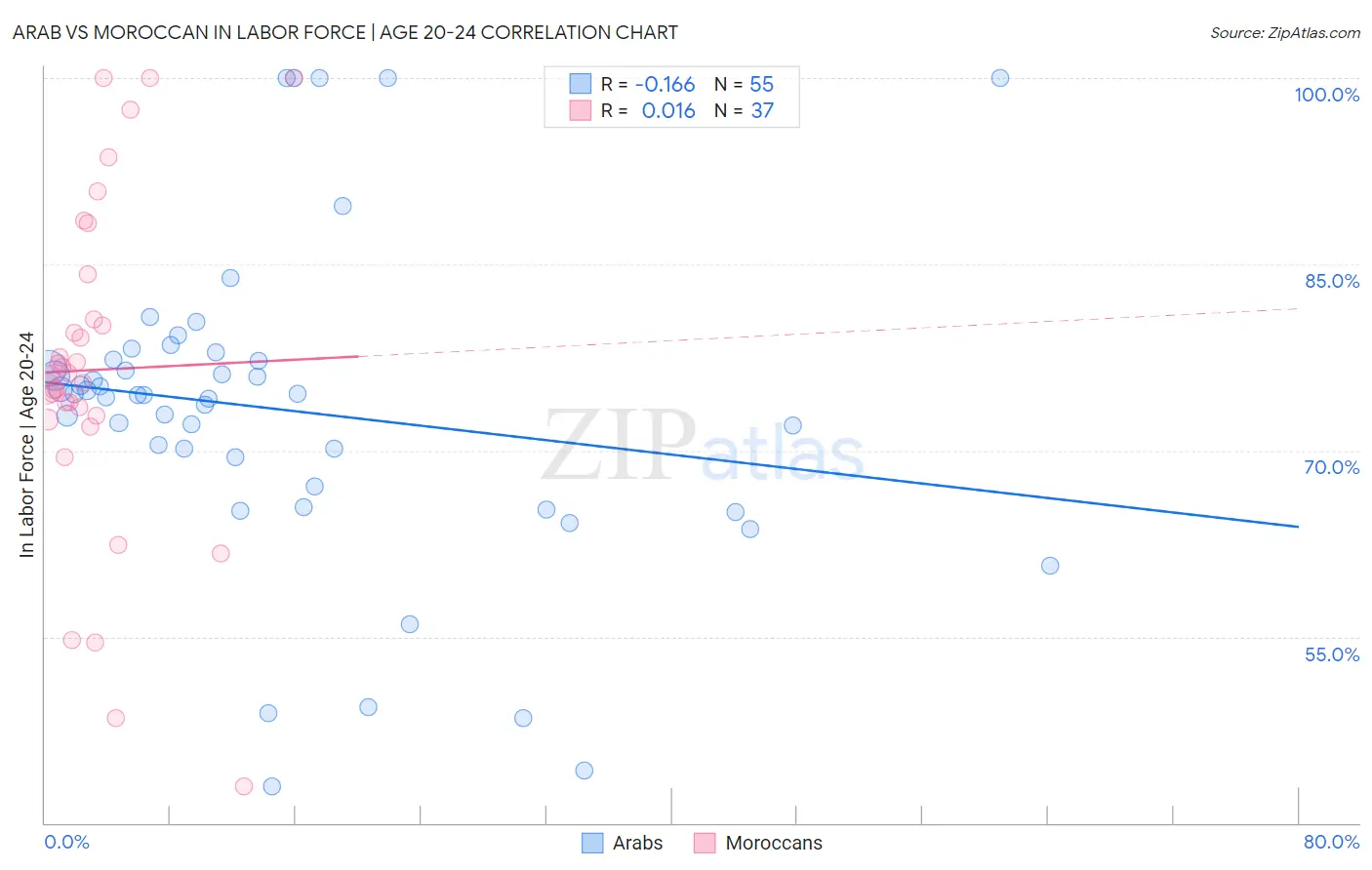Arab vs Moroccan In Labor Force | Age 20-24
COMPARE
Arab
Moroccan
In Labor Force | Age 20-24
In Labor Force | Age 20-24 Comparison
Arabs
Moroccans
74.6%
IN LABOR FORCE | AGE 20-24
15.8/ 100
METRIC RATING
209th/ 347
METRIC RANK
74.7%
IN LABOR FORCE | AGE 20-24
20.4/ 100
METRIC RATING
202nd/ 347
METRIC RANK
Arab vs Moroccan In Labor Force | Age 20-24 Correlation Chart
The statistical analysis conducted on geographies consisting of 486,568,832 people shows a poor negative correlation between the proportion of Arabs and labor force participation rate among population between the ages 20 and 24 in the United States with a correlation coefficient (R) of -0.166 and weighted average of 74.6%. Similarly, the statistical analysis conducted on geographies consisting of 201,764,515 people shows no correlation between the proportion of Moroccans and labor force participation rate among population between the ages 20 and 24 in the United States with a correlation coefficient (R) of 0.016 and weighted average of 74.7%, a difference of 0.12%.

In Labor Force | Age 20-24 Correlation Summary
| Measurement | Arab | Moroccan |
| Minimum | 42.9% | 42.9% |
| Maximum | 100.0% | 100.0% |
| Range | 57.1% | 57.1% |
| Mean | 73.2% | 76.5% |
| Median | 74.5% | 76.1% |
| Interquartile 25% (IQ1) | 67.1% | 72.6% |
| Interquartile 75% (IQ3) | 77.3% | 82.4% |
| Interquartile Range (IQR) | 10.2% | 9.8% |
| Standard Deviation (Sample) | 12.8% | 13.3% |
| Standard Deviation (Population) | 12.7% | 13.2% |
Demographics Similar to Arabs and Moroccans by In Labor Force | Age 20-24
In terms of in labor force | age 20-24, the demographic groups most similar to Arabs are Immigrants from Uruguay (74.6%, a difference of 0.0%), Albanian (74.6%, a difference of 0.010%), Uruguayan (74.6%, a difference of 0.020%), Immigrants from Australia (74.6%, a difference of 0.030%), and Sioux (74.6%, a difference of 0.040%). Similarly, the demographic groups most similar to Moroccans are Choctaw (74.7%, a difference of 0.020%), Nigerian (74.7%, a difference of 0.030%), Taiwanese (74.7%, a difference of 0.060%), Immigrants from Northern Africa (74.6%, a difference of 0.060%), and Immigrants from Italy (74.6%, a difference of 0.070%).
| Demographics | Rating | Rank | In Labor Force | Age 20-24 |
| Eastern Europeans | 25.4 /100 | #195 | Fair 74.8% |
| Immigrants | Vietnam | 25.1 /100 | #196 | Fair 74.7% |
| Panamanians | 25.0 /100 | #197 | Fair 74.7% |
| Immigrants | Nigeria | 24.2 /100 | #198 | Fair 74.7% |
| Taiwanese | 23.2 /100 | #199 | Fair 74.7% |
| Nigerians | 21.9 /100 | #200 | Fair 74.7% |
| Choctaw | 21.4 /100 | #201 | Fair 74.7% |
| Moroccans | 20.4 /100 | #202 | Fair 74.7% |
| Immigrants | Northern Africa | 17.9 /100 | #203 | Poor 74.6% |
| Immigrants | Italy | 17.6 /100 | #204 | Poor 74.6% |
| Inupiat | 17.6 /100 | #205 | Poor 74.6% |
| Sioux | 17.5 /100 | #206 | Poor 74.6% |
| Albanians | 16.2 /100 | #207 | Poor 74.6% |
| Immigrants | Uruguay | 15.8 /100 | #208 | Poor 74.6% |
| Arabs | 15.8 /100 | #209 | Poor 74.6% |
| Uruguayans | 15.1 /100 | #210 | Poor 74.6% |
| Immigrants | Australia | 14.7 /100 | #211 | Poor 74.6% |
| Creek | 13.3 /100 | #212 | Poor 74.5% |
| Peruvians | 13.3 /100 | #213 | Poor 74.5% |
| Immigrants | Southern Europe | 13.2 /100 | #214 | Poor 74.5% |
| Immigrants | Ghana | 12.7 /100 | #215 | Poor 74.5% |